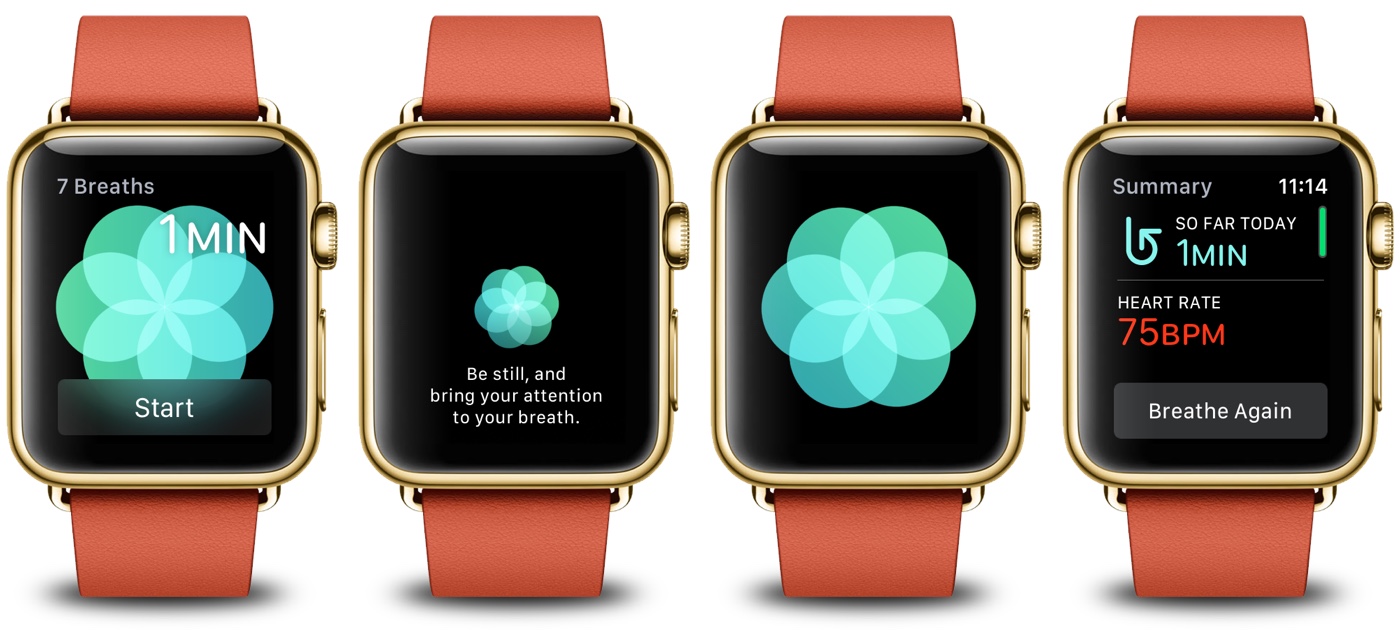Last June, during Apple’s WWDC 2016 Keynote, the company showed off the features of watchOS 3, their new operating system for the Apple Watch. Among the many features was a little app called “Breathe,” which is designed to help users take a few moments during the day to relax, focus, and meditate. This article will take a look at how the watchOS 3 Breathe app on the Apple Watch is used, and also some of the science theory behind the app.

How the Breathe App Works
When watchOS 3 has been installed on an Apple Watch, the user will find an app called “Breathe” has come along for the ride. The app by default reminds users every five hours to take a moment to relax and take deep measured breaths.
Using onscreen prompts and graphics, along with haptic prompts, the app prompts the user to “be still and bring attention to your breath.” It does this by guiding the user through a one-minute session of seven deep breaths. This can all be adjusted in the iPhone “Watch” app. Breathe can be adjusted to remind a user to breathe as often as every hour, or take as long as seven hours between session. It can also be set for 4 breaths per minute, up to 10 breaths per session.
When a Breathe reminder pops-up on the Apple Watch screen, a user can either begin a breathing session, or simply ignore it. Users can also add a Breathe complication to their favorite watch face, which allows them to view a summary of activity for the day, and/or start a new session immediately.
Once a session starts, a group of circles on the Watch’s screen gradually expands, letting the user to know it is time to slowly inhale. Then the circles will begin to contract, notifying the user that it is time to begin exhaling. The graphics display is also accompanied by haptic feedback. Once a user gets used to the app, the haptic feedback alone can prompt the user to inhale and exhale without the need to stare at the screen. Perfect for breathing with your eyes closed to aid the relaxation.
At the end of each session, the screen displays a summary screen informing the user of how many Breathe sessions they have completed for the day, and what their heart rate was during the most recent session. Users can also tap the “Breathe Again” button to start another session, if they wish.
What is the Science Behind the Breathe App?
During the June Keynote, Apple didn’t go into detail about Mindfulness Meditation, which is the basis for the Breathe app. However, there has been quite a bit of scientific study, which supports claims that by a person concentrating on their breathing, they can help alleviate their stress, and reduce anxiety.
Scientific American notes Mindfulness Meditation was originally an ancient Buddhist meditation technique, but in recent years mindfulness has evolved into a range of secular therapies and courses, most of them focused on being aware of the present moment and simply noticing feelings and thoughts as they come and go.
The technique has been accepted as a useful therapy for anxiety and depression for around a decade, it’s being explored by schools, pro sports teams and military units as a way to enhance performance. The technique is also said to be showing promise as a way of helping sufferers of chronic pain, addiction and tinnitus.
Brain imaging techniques have revealed that the practice can profoundly change the way different regions of the brain communicate with each other – and therefore how we think – permanently.
MRI scans taken after an eight-week course of mindfulness practice show a shrinking of the amygdala, the brain’s “fight or flight” center. As the amygdala shrinks, the pre-frontal cortex – associated with higher order brain functions such as awareness, concentration and decision-making – becomes thicker. The connection between the amygdala and the rest of the brain gets weaker, while the connections between areas associated with attention and concentration get stronger. This appears to cause more primal responses to stress to be superseded by more thoughtful ones.
My Personal Experience With Breathe
I have been using watchOS 3 since it became available as a developer beta in June. However, only in the last month or so have I began actually taking time for daily Breathe sessions. While I haven’t noticed an enhancement of any personal performance measurements, I have found the sessions do help clear my mind, and at least make for a nice break during the workday.
Perhaps taking time to “Breathe” during the day won’t offer me a fantastic stress-relieving breakthrough, or even take my mind off a headache or other issues, but it has brought me a bit of midday relaxation, and for a free Watch app, that isn’t a bad thing.

